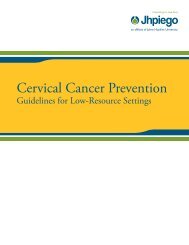Manual for Male Circumcision under Local Anaesthesia
Manual for Male Circumcision under Local Anaesthesia
Manual for Male Circumcision under Local Anaesthesia
Create successful ePaper yourself
Turn your PDF publications into a flip-book with our unique Google optimized e-Paper software.
<strong>Male</strong> circumcision <strong>under</strong> local anaesthesia<br />
Version 3.1 (Dec09)<br />
Post-exposure prophylaxis is not indicated:<br />
1. if the exposed person is already HIV-positive from a previous exposure;<br />
2. in the context of chronic exposure (e.g. repeated exposure to HIV from<br />
unprotected sexual intercourse with a known HIV-positive partner);<br />
3. if the exposure poses no risk of transmission, e.g.:<br />
• exposure of intact skin to potentially infectious body fluids;<br />
• exposure to non-infectious body fluids (faeces, saliva, urine, sweat);<br />
• exposure to body fluids from a person known to be HIV-negative,<br />
unless the source person is identified as being at high risk of having<br />
been recently infected and currently within the window period <strong>for</strong><br />
seroconversion.<br />
Step 3. Testing and counselling<br />
• If testing is available, the exposed person should be offered the chance to<br />
be tested <strong>for</strong> HIV and receive appropriate counselling. The person should<br />
always have the choice to refuse testing.<br />
• Do not delay starting ARVs <strong>for</strong> PEP while waiting <strong>for</strong> HIV test results. The<br />
exposed person could start taking ARVs <strong>for</strong> PEP immediately, and stop<br />
the treatment if the test results reveal that he or she is already HIVpositive.<br />
• Antiretroviral drugs <strong>for</strong> PEP should be started as soon as possible and in<br />
any case within 72 hours after exposure.<br />
• The drugs should be taken continuously <strong>for</strong> 28 days.<br />
• Each circumcision clinic should either have the necessary drugs in stock<br />
or know where they can be obtained, so that treatment can be started<br />
within 72 hours.<br />
• Whenever possible, the source patient should also be tested, with his or<br />
her in<strong>for</strong>med consent. If the test results show that the source person is<br />
negative, PEP can be stopped.<br />
• Counselling should include provision of in<strong>for</strong>mation on the importance of<br />
adhering to treatment, and in<strong>for</strong>mation on HIV prevention in general and<br />
in the workplace. The person should be advised to use condoms, and not<br />
to donate blood or organs <strong>for</strong> up to 6 months after exposure.<br />
• Women of childbearing age should be advised to use contraception, and<br />
alternatives to breastfeeding should be discussed with women currently<br />
feeding their infants. There is a high risk of transmitting HIV to the infant if<br />
the mother becomes infected during breastfeeding.<br />
Step 4. Antiretroviral medications <strong>for</strong> post-exposure prophylaxis<br />
If national guidelines on post-exposure prophylaxis exist, these should be<br />
followed. If not, WHO recommendations may be applied. WHO recommends<br />
a two-drug PEP regimen, unless there is suspicion or evidence of drug<br />
resistance. The standard PEP regimen consists of two nucleoside reverse<br />
transcriptase inhibitors (NRTIs). The possible regimens are given in Table<br />
8.4.<br />
Prevention of Infection Chapter 8-19
















